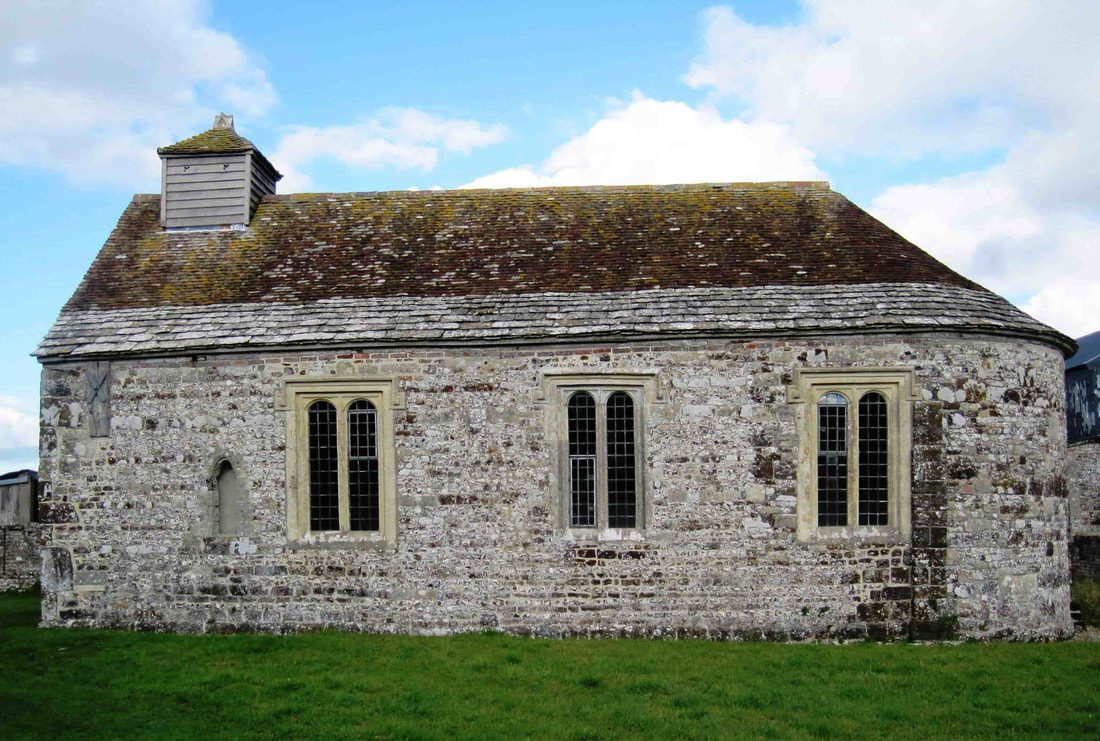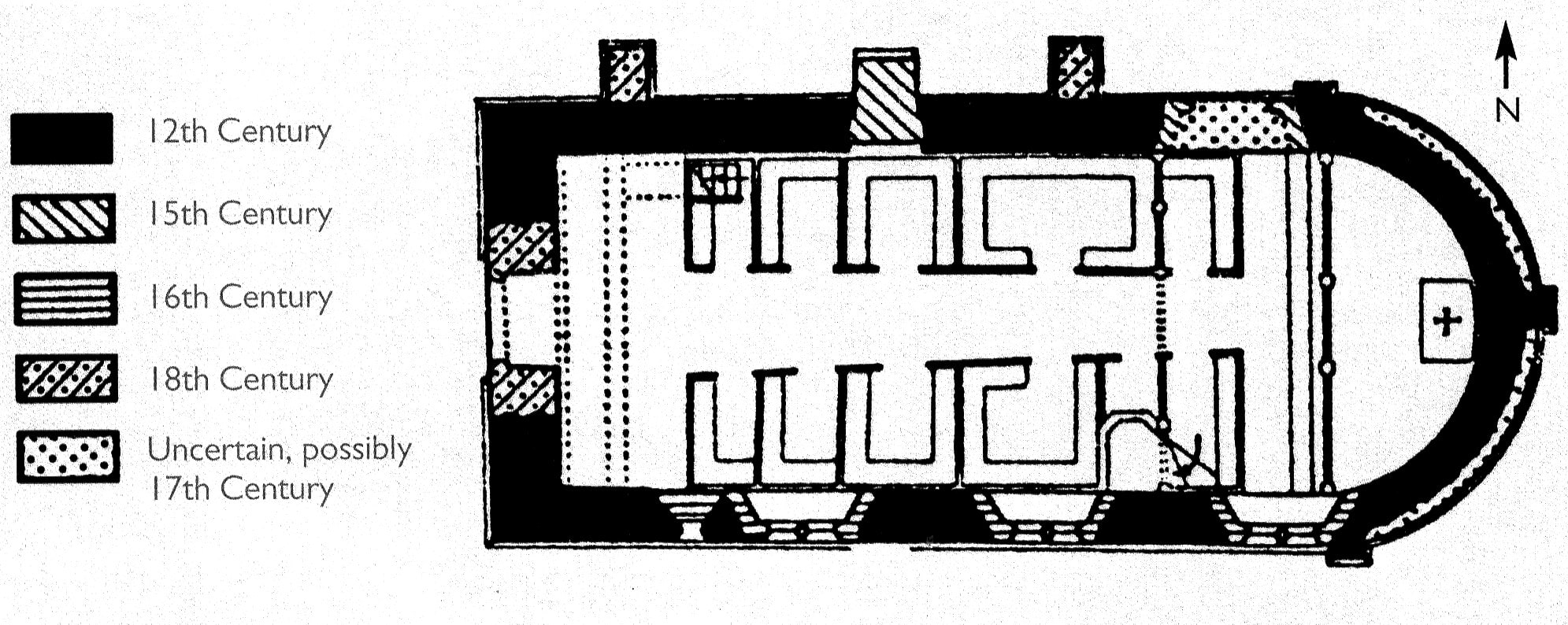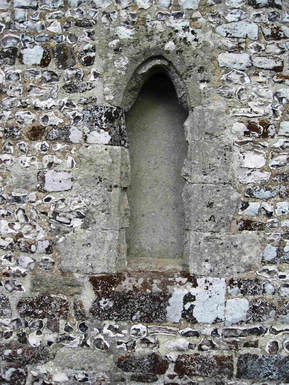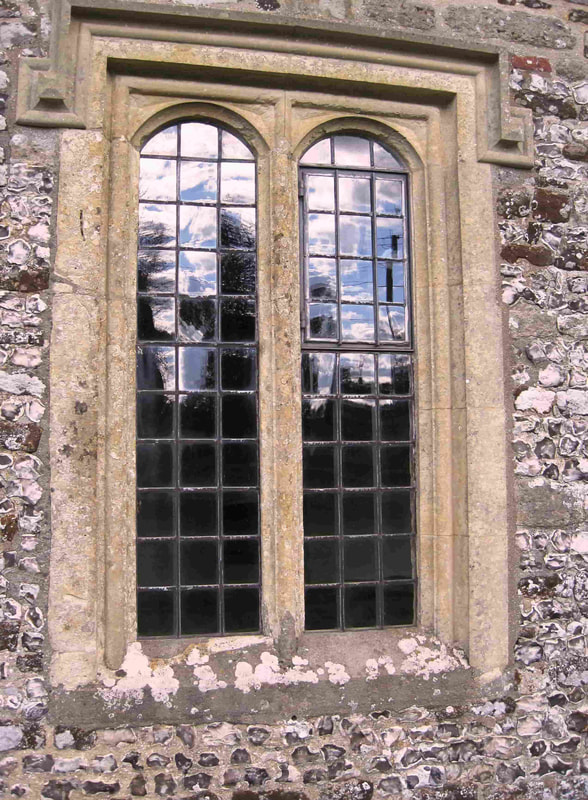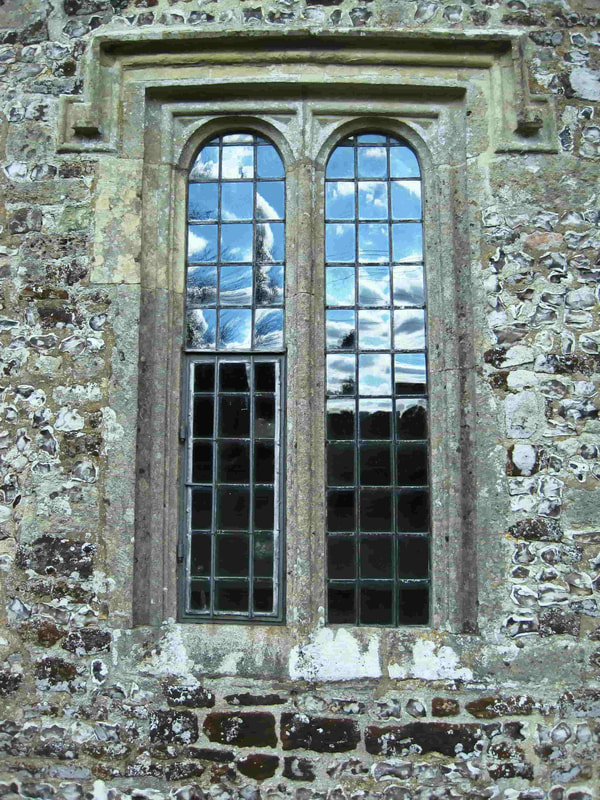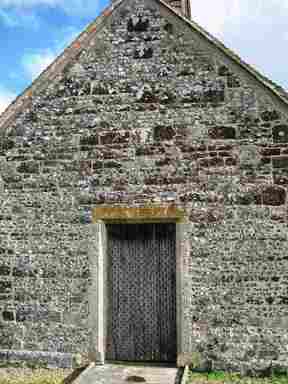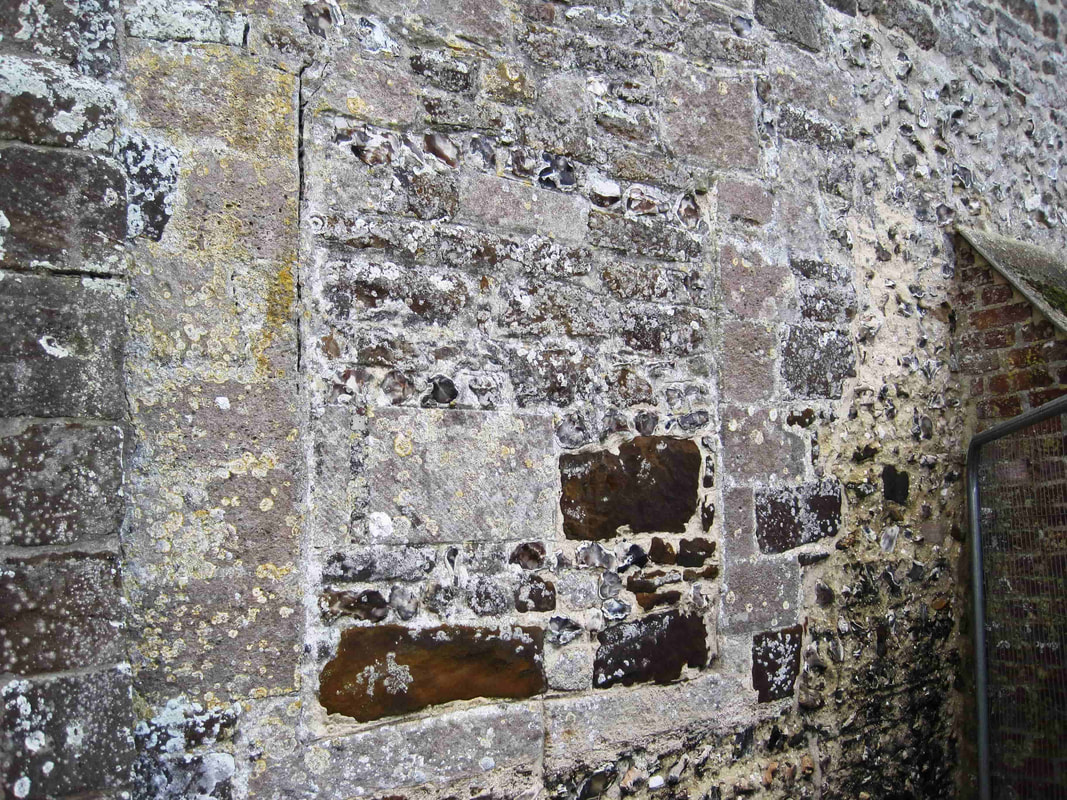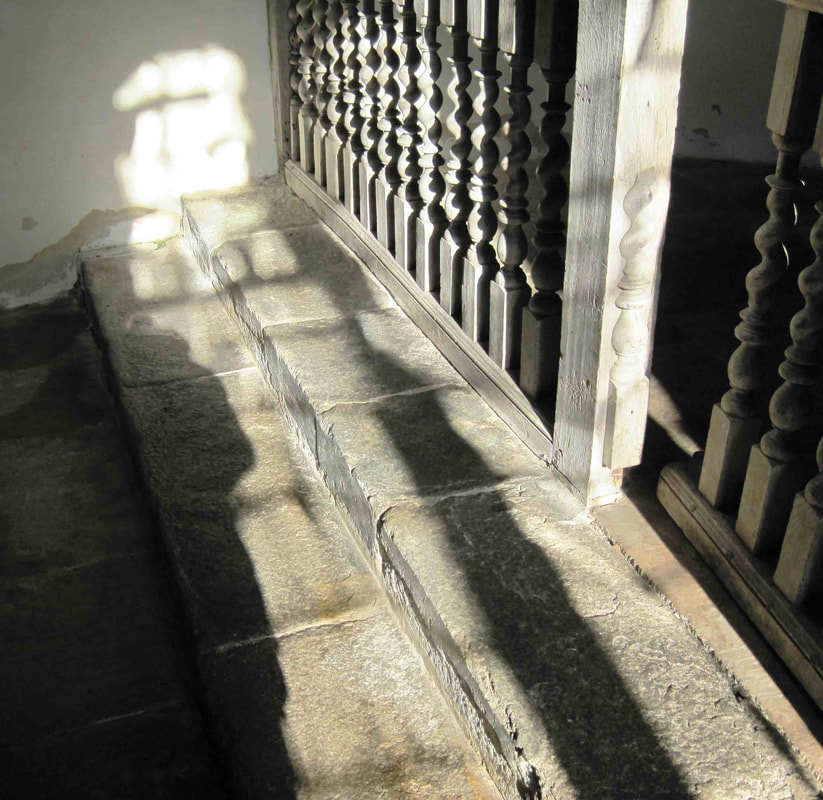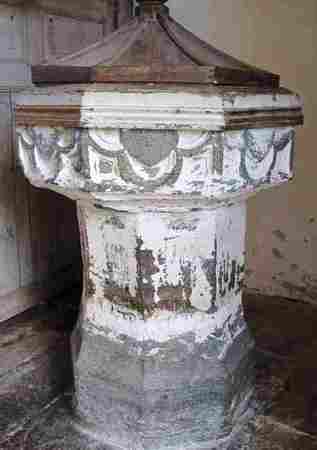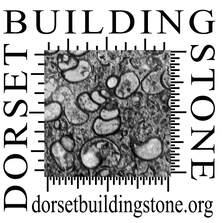St. Andrew’s Church, Winterborne Tomson, in Anderson parish.
NGR: SY88475 97423, 50.7763 -2.1648 Lead author: JT.
St. Andrew’s church at Winterborne Tomson is the only single cell Norman church with an apsidal east end in Dorset. Although unaltered in plan since being built in the early 12th century, it has been rebuilt and refurnished in the 15th, 16th, 18th and 20th centuries.
Although the single lancet window in the south wall has the 16th century ornament in the Royal Commission plan, it is Norman in shape, considered to be 12th century, and was built of Purbeck Burr limestone. The 16th century section is the infilling, not the original frame.
Although the single lancet window in the south wall has the 16th century ornament in the Royal Commission plan, it is Norman in shape, considered to be 12th century, and was built of Purbeck Burr limestone. The 16th century section is the infilling, not the original frame.
Rebuilding and repairs.
In the 15th century the walls were raised by about 0.6m with extra Heathstone and mixed rubble, and the present roof with a curve over the apse installed. The clay tiles were made locally, but perhaps not as early as the 15th century. The Purbeck stone tiles may originally have covered the whole roof, but proved too heavy.
The three windows in the south wall marked as 16th century are thought by the Churches Conservation Trust (CCT) to be 17th century at the earliest. The limestones are of different colours. The centre square-headed one and part of the left square headed may be the pale Corallian limestone from Marnhull, but the upper part of the left square headed and the majority of the right are a darker colour. This might be the Corallian limestone from the quarries nearer Todber, unless very much later repairs of Bath stone
were used.
In the 15th century the walls were raised by about 0.6m with extra Heathstone and mixed rubble, and the present roof with a curve over the apse installed. The clay tiles were made locally, but perhaps not as early as the 15th century. The Purbeck stone tiles may originally have covered the whole roof, but proved too heavy.
The three windows in the south wall marked as 16th century are thought by the Churches Conservation Trust (CCT) to be 17th century at the earliest. The limestones are of different colours. The centre square-headed one and part of the left square headed may be the pale Corallian limestone from Marnhull, but the upper part of the left square headed and the majority of the right are a darker colour. This might be the Corallian limestone from the quarries nearer Todber, unless very much later repairs of Bath stone
were used.
18th century work includes the west doorway, possibly of Marnhull limestone with a dark lintel, which is Ham Hill Stone, and two buttresses on the north wall, of brick.
Considerable repairs were carried out under the supervision of A.R. Powys, Secretary of the Society for the Preservation of Ancient Buildings, in 1930, after many years of neglect. Their archives include a report of the Diocesan committee, and a letter to the SPAB from Powys. The images are linked courtesy of the Society for the Preservation of Ancient Buildings (SPAB).
In 1974 the CCT took over care of the church and several repairs have been undertaken since then.
Considerable repairs were carried out under the supervision of A.R. Powys, Secretary of the Society for the Preservation of Ancient Buildings, in 1930, after many years of neglect. Their archives include a report of the Diocesan committee, and a letter to the SPAB from Powys. The images are linked courtesy of the Society for the Preservation of Ancient Buildings (SPAB).
In 1974 the CCT took over care of the church and several repairs have been undertaken since then.
Sources of stone in the present church
The major building stone is Flint, which could have been gathered from the valley gravels or the Clay with Flints.
The nearest dimension stone available was the Heathstone from the Tertiary beds on the higher ground south of the Winterborne in the Warmwell Farm and Lytchett Matravers Sandstone Members of the London Clay. This has also been used for the lower courses of the cottages and farmhouse that comprise the settlement of Tomson. No quarries have been found in these beds, but concretions could have been gathered in the fields, or within the valley gravels.
The mixed stone of the walls includes Heathstone and Flint with the pale Marnhull limestone, some Purbeck limestone and Upper Greensand. Most of the stone from Purbeck used for windows is the Burr, the Broken Shell Limestone that was quarried in the valley between Swanage and Worth Matravers. The CCT also record ‘golden-coloured limestone found in the west of the county’, but this seems to me to be too far away unless they are referring to Ham Hill Stone.
Possible transport routes.
Carriage of Purbeck limestone from the quarries near Swanage has been recorded from Roman times. National Trust archaeologists describe the route as being along the valley to Corfe Common and to the workshops in Corfe Castle by sled, then over the Poole Formation heathlands to Ower, and finally by boat to Hamworthy, Poole. Once in a boat the Purbeck stone could be carried a long way, for instance to Christchurch and up the Stour. The Winterborne enters the Stour below Sturminster Marshall, but the stream even in flood is shallow, so the masons would need to use wheeled transport in the relatively flat ground of the valley.
The major building stone is Flint, which could have been gathered from the valley gravels or the Clay with Flints.
The nearest dimension stone available was the Heathstone from the Tertiary beds on the higher ground south of the Winterborne in the Warmwell Farm and Lytchett Matravers Sandstone Members of the London Clay. This has also been used for the lower courses of the cottages and farmhouse that comprise the settlement of Tomson. No quarries have been found in these beds, but concretions could have been gathered in the fields, or within the valley gravels.
The mixed stone of the walls includes Heathstone and Flint with the pale Marnhull limestone, some Purbeck limestone and Upper Greensand. Most of the stone from Purbeck used for windows is the Burr, the Broken Shell Limestone that was quarried in the valley between Swanage and Worth Matravers. The CCT also record ‘golden-coloured limestone found in the west of the county’, but this seems to me to be too far away unless they are referring to Ham Hill Stone.
Possible transport routes.
Carriage of Purbeck limestone from the quarries near Swanage has been recorded from Roman times. National Trust archaeologists describe the route as being along the valley to Corfe Common and to the workshops in Corfe Castle by sled, then over the Poole Formation heathlands to Ower, and finally by boat to Hamworthy, Poole. Once in a boat the Purbeck stone could be carried a long way, for instance to Christchurch and up the Stour. The Winterborne enters the Stour below Sturminster Marshall, but the stream even in flood is shallow, so the masons would need to use wheeled transport in the relatively flat ground of the valley.
Images 8 & 9. The altar steps and the font are of Purbeck Marble.
The Upper Greensand could have been carried down the Stour from Shaftesbury by boats of shallow draught in the centuries before the mill weirs were built.
Marnhull and Todber stone could also have been carried down the Stour, landed at Sturminster Marshall and carted along the Winterborne valley.
Heathstone would have to be transported by cart and across the river. However, such a small stream is easily bridged, and for many months is dry.
References.
1. Royal Commission: http://www.british-history.ac.uk/rchme/dorset/vol3/pp4-8.
2. SPAB Archive – Note of file contents. linked
3.1928 Powys. Letter to SPAB Committee.
4.1929 SPAB Annual Report.
5.1930 Salisbury Diocesan Report
6.1931 Powys. Letter to Salisbury Diocesan Advisory Committee
N.B. The original files from SPAB are available below as .pdfs.
Marnhull and Todber stone could also have been carried down the Stour, landed at Sturminster Marshall and carted along the Winterborne valley.
Heathstone would have to be transported by cart and across the river. However, such a small stream is easily bridged, and for many months is dry.
References.
1. Royal Commission: http://www.british-history.ac.uk/rchme/dorset/vol3/pp4-8.
2. SPAB Archive – Note of file contents. linked
3.1928 Powys. Letter to SPAB Committee.
4.1929 SPAB Annual Report.
5.1930 Salisbury Diocesan Report
6.1931 Powys. Letter to Salisbury Diocesan Advisory Committee
N.B. The original files from SPAB are available below as .pdfs.
| spab_archive_-_winterborne_tomson_church_letter_30_nov_1928__spab_report_extract.pdf |
| spab_archive_-_note_of_file_contents_-_winterborne_tomson_church.pdf |
| spab_archive_-_winterborne_tomson_church_documents_1931.pdf |
Text and images JT 17.11.18

